This page is no longer current and is provided for archival and research purposes.
Section 4: Nutrition Tips
Nutrition Q & A
How can I reduce the amount of sugar served in my SNP?
While children and youth can enjoy sweetened foods and beverages in small amounts, Canada's Food Guide recommends limiting foods and drinks that are high in sugar.
- Use pureed fruit (e.g., applesauce) as a sweetener for baked goods instead of sugar;
- Add pureed, whole or frozen fruit to plain yogurt and/or cereal;
- Add spices like cinnamon to plain oatmeal;
- Make homemade smoothies with milk, yogurt and fruit; or
- Add lemon, lime or orange slices to water.
Is multigrain a whole grain?
Multigrain is not the same as whole grain or whole wheat. Whole grain means the product has all three parts of the kernel (e.g., the germ, the bran, and the endosperm). Multigrain means the product has multiple kinds of grains, but these grains may be refined. Whole grain foods are a healthier choice because they contain more nutrients and fibre.
Choosing whole grains is easier if you check the ingredient list. Some grains are usually eaten in their whole form so this is how you will see them written on the ingredient list (e.g., barley, buckwheat, corn, cracked wheat, oats, quinoa, rye, spelt, wild rice, wheat berries).
Other foods containing whole grains may have the words "whole" or "whole grain" followed by the name of the grain (e.g., whole rye, whole grain polenta, whole corn flour, stone ground whole wheat, whole grain whole wheat).
Is sodium the same as salt?
Sodium is found in salt. All types of salt are high in sodium. Kosher salt, sea salt, fleur de sel, gourmet salt and smoked salt all have the same amount of sodium as table salt. They are not healthier choices. Foods low in sodium or with no added salt should be served when possible. Most Canadian children consume too much sodium, which increases their risk for negative health effects.
Why are deli meats in the "Do Not Serve" Category?
Processed meat like cold cuts, ham, bacon, sausages and hot dogs contain nitrates and nitrites. These are added to meat to prevent them from spoiling and to improve colour and flavour. Nitrates and nitrites are not cancer causing alone, but can be changed in our bodies to form compounds associated with an increased risk of cancer.
Does your recipe meet the SNP Nutrition Guidelines?
You may have a recipe that you would like to use, but don't know if it meets the SNP Nutrition Guidelines. You can use the recipe's ingredient list and Nutrition Facts table (if provided) to see if a recipe can be served.
Recipes may not have all the nutrient information found in a Nutrition Facts table and they may not list the ingredients by weight. In these situations, use the list of ingredients to decide if it should be served to children and youth in your program.
For most recipes, it is encouraged that all of the main ingredients be on the "Serve" lists from the SNP Food and Beverage Choice Tables (e.g., pizzas, smoothies).
For baked goods, choose recipes that are made with whole wheat flour, whole grains, or bran and contain less sugar. Look for recipes that include at least two of the following and use the portion size suggested below:
- Contain more than half of the flour as whole wheat/whole grain;
- Contain bran, oats or ground flax;
- Contain grated vegetable (e.g., carrot, zucchini), or unsweetened fruit (e.g., mashed banana, unsweetened applesauce, drained canned pineapple); or
- Contain less than or equal to 8 g of sugar per 30 g serving (if Nutrition Facts table and weight is available).
Here are some serving size examples:
| Food item | Serving size |
|---|---|
| Cookie | Not more than 6 cm (about 2.5 inches) in diameter |
| Loaf Slice | Not more than 2 cm (about ¾ inch) thick |
| Muffin | The size of a tennis ball or smaller |
Still not sure if your recipe meets the SNP nutrition guidelines? Check with your SNP Lead Agency or local public health unit.
Serving sizes
Canada's Food Guide gives examples of one serving of different foods in each food group. However, portion sizes should be adjusted to reflect the age and developmental stage of children and youth. Younger children may need less food than older children. All children and youth should be encouraged to pay attention to their natural hunger and fullness cues.
Canada's Food Guide Serving Sizesfootnote 8
Using your hand can be a helpful way to estimate Canada's Food Guide serving sizes. Use the images that follow to help you.
Vegetables and Fruits


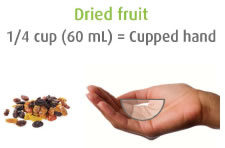

Grain Products
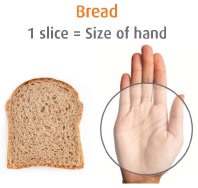

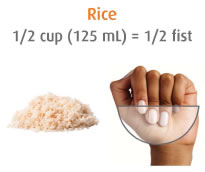
Milk and Alternatives
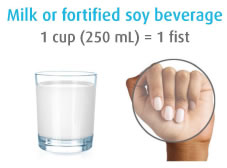
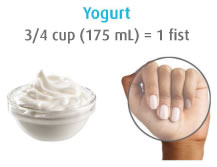
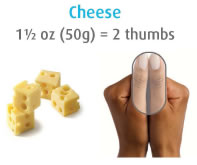
Meat and Alternatives

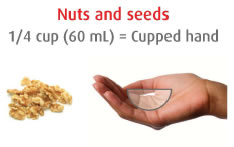
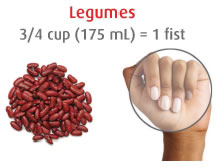
Handy Guide to Serving Sizes, Copyright © Dietitians of Canada 2016. All rights reserved.
Footnotes
- footnote[4] Back to paragraph Health Canada. 2007. Foods to Limit.
- footnote[5] Back to paragraph Heart and Stroke Position Statement, 2014.
- footnote[6] Back to paragraph Health Canada. 2012. Sodium in Canada.
- footnote[7] Back to paragraph Canadian Cancer Society. 2016. Cured, smoked and salt- preserved foods.
- footnote[8] Back to paragraph Dietitians of Canada. 2016. Handy Guide to Serving Sizes.